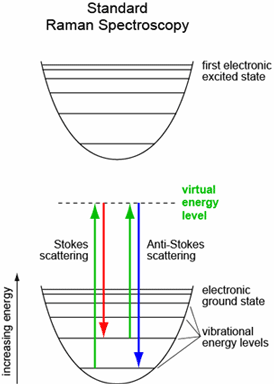
Life Science Optics

Raman spectroscopy measurements generally face two limitations:
(1) Raman scattering cross sections are small, requiring intense lasers and sensitive detection systems to achieve adequate signal
(2) the signal-to-noise ratio is further limited by fundamental, intrinsic noise sources like sample autofluorescence.
Raman measurements are most commonly performed with green, red, or near-infrared (IR) lasers, largely because of the availability of established lasers and detectors at these wavelengths. By instead measuring Raman spectra in the ultraviolet (UV) wavelength range, both of the above limitations can be substantially alleviated.
Visible and near-IR lasers have photon energies below the first electronic transitions of most molecules, but when the photon energy of the laser lies within the electronic spectrum of a molecule, as is the case for UV lasers and most molecules, the intensity of Raman-active vibrations can increase by many orders of magnitude. This effect is called "resonance-enhanced" Raman scattering.


Further, although UV lasers tend to excite strong autofluorescence, it typically occurs only at wavelengths above about 300 nm, independent of the UV laser wavelength. Since even a 4000 cm–1 (very large) Stokes shift leads to Raman emission below 300 nm when excited by a common 266 nm laser, autofluorescence simply does not interfere with the Raman signal making high signal-to-noise ratio measurements possible.

As an increasing number of compact, affordable, and high-power UV lasers have become available, like the quadrupled, diode-pumped Nd:YAG lasers at 266 nm and NeCu hollow-cathode metal-ion lasers at 248.6 nm, ultra-sensitive UV Raman spectroscopy has become a more common technique. Optical filter availability in the UV range, however, has continued to lag behind. Semrock is proud to offer a number of extremely high-performance filters that are ideal for UV Raman spectroscopy. RazorEdge® long-wave-pass filters and MaxLine® Laser-line Clean-up filters offer a selection to complement the most popular UV lasers.
High Performance Raman Spectroscopy
Optical Filters Go Deeper from the March 2008 Photonics Spectra